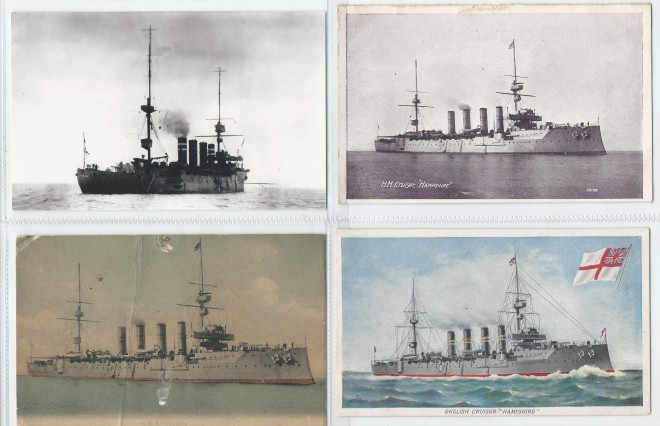
This week has brought news of two surveys of the wreck of HMS Hampshire, which sank after hitting a mine off Orkney on 5 June 1916. At the time she was taking Lord Kitchener, the Secretary of State for War, to Russia for talks. In all, 737 men died, and only 12 survived.
You may have read on our blog about the ROV (remotely operated underwater vehicle) survey to be carried out by the University of the Highlands and Islands (UHI) Archaeology Institute.
That survey went ahead earlier this month – with one of our project’s volunteers, Andrew Hollinrake, on board – and the first results have been announced.

The survey confirms previous findings that HMS Hampshire capsized as she sank and lies with an upturned hull on the seabed, in approximately 60 metres of water.
The superstructure is compressed and buried in the silt of the seabed. The hull is damaged in places, exposing parts of the interior, including torpedo tubes and machinery.

The UHI Archaeology Institute was working in partnership with Seatronics – an Acteon Company, Teledyne RESON, Roving Eye Enterprises Ltd and Triscom Marine Ltd. You can read more about what was found – and what happens next – on the institute’s own blog: https://archaeologyorkney.com/2016/05/26/hms-hampshire-initial-rov-images/.

Meanwhile, a second survey was announced this week which, like the ROV survey, is operating with permission from the Ministry of Defence.
A team of specialist international divers will undertake a photographic and 3D-imaging survey of the wreck. They will be diving from MV Huskyan, which is based in Stromness, Orkney.
Expedition leader Rod Macdonald says the objective is to undertake a detailed survey of HMS Hampshire, and to record it using stills and video photography.
A detailed written and visual survey report will be compiled, which will be made available to the MoD, museums in Orkney and Historic Environment Scotland.
There is more about the dive survey in BBC Radio Orkney’s Around Orkney programme, about 12 minutes in…
https://soundcloud.com/radio-orkney/around-orkney-thursday-26th-of-may-2016
Update to blog (28.5.16): On Wednesday (1 June) at 7.30pm there will be an illustrated talk ‘Remembering The Hampshire’, presented by the Archaeology Institute of the University of the Highlands and Islands, using some of the dive footage and scans. It’s at Birsay Community Hall and it’s a free event.
Graham Brown
